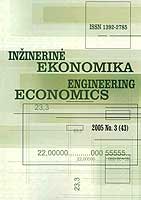Model of Strategic Analysis Tools Typology
Model of Strategic Analysis Tools Typology
Author(s): Asta Savanevičienė, Sigitas Vaitkevičius, Gediminas MerkysSubject(s): Economy
Published by: Kauno Technologijos Universitetas
Keywords: tools; strategic analysis; taxonomy; strategic management; strategic planning.
Summary/Abstract: With the growing number of tools to be used for stra-tegic analysis it is getting more and more difficult to make a choice. This problem has been tackled by working out different taxonomies of tools of strategic management and planning which include number of tools used for strategic analysis. Following the review of the available taxonomies it has been found that (1) they failed to en-compass all tools classification criteria necessary for strategic analysis, (2) they were not oriented to the clas-sification of strategic analysis tools and to the highlight-ing specific typological features of the tools used for stra-tegic analysis. In this article the analysis of the available taxono-mies performed enabled to select 41 tool to be used for strategic analysis which were later included into the “ex-pert evaluation questionnaire of strategic analysis tools”. All of them were theoretically divided on the framework of certain classification attitude. During the study, the classification of tools to be used for theoretical strategic analysis has been studied in detail according to 19 classi-fication criteria / indicators. By comparing practical and theoretical tools taxonomies the classification criteria were selected and analyzed in detail which are equally important both in practical and theoretical respect. On the framework of this the “questionnaire of strategic analysis tools expert evaluation” was formed. The corre-spondence survey of experts using anonymous question-naire has been chosen for the study. As the result of this paper, it was stated that the evaluation of the tools of strategic analysis according to the 19 chosen criteria has been partly justified. By means of this study the tools can be classified according to 16 different features. Thus, the 41 tool typological model has been comprised for strategic analysis of the used tool. According to the judgment of the authors of this paper, this will give the possibility in the future not only to com-pare the above mentioned tools with each other, but also to include and position new tools to be used for strategic analysis. The typological model enables to form the groups of homogeneous tools of strategic analysis ac-cording to some specific criteria (sets or portfolios). Such groups can help to more fully study the tools of strategic analysis, as well as their investigation, research and modification. The designed typological model makes it possible to form individual portfolios of the tools of strategic analy-sis for the managers of various organizations according to the previously stated features or characteristics. By means of the designed model, the managers would be able to choose such tools that would be more informative. Besides, the organization executives would also be able to more easily choose the tools that would not duplicate the information of each other. This will allow the leaders to more effectively use the tools of strategic analysis.
Journal: Engineering Economics
- Issue Year: 2006
- Issue No: 2 (47)
- Page Range: 99-109
- Page Count: 11
- Language: English

